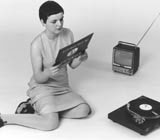Needles must
VinylVideo technology should have been a precursor to both video and DVD, but it never even existed – until now. Paul Murphy puts you in the frame

VinylVideo is the missing media link in home entertainment that never was. Half video recorder, half record player, VinylVideo is what we would have had if no one had ever invented the video cassette or the DVD player. A record player’s turntable is hooked up to a black-and-white television set via the VinylVideo ‘black box’, thus somewhat implausibly enabling, as the name would imply, the playback of video stored in the grooves on vinyl records. Both in terms of its appearance and the technology, VinylVideo bridges the gap between the arrival of the first television sets in the home and home video recorders, the latter bringing with them the watch-what-you-want-when-you-want culture.
The Frankenstein child of artist Gebhard Sengmüller and collaborators Martin Diamant (an information scientist), Günter Erhart (an experimental physicist) and Rike Frank (curator and writer), VinylVideo is inspired by what its inventor Sengmüller calls ‘a fake archaeology of media’, a rummaging in the dustbin of technological advancement and consumer history to see what has been omitted or lost along the way.
Due to the bandwidth restrictions of a needle and a rotating vinyl groove (1/200th that of TV, since you ask), each 12-inch record only holds a decidedly low-res, stuttering eight frames a second video with a synchronised soundtrack. They’re also limited to eight minutes per side, which rules them out as a media for anything longer than a music video, and the current library of discs is somewhat small. Now all this obviously isn’t going to have Sony and JVC quaking in their boots or Blockbuster wondering if another format war is in the offing, but that’s hardly the point.
The VinylVideo technology is reminiscent of Fisher-Price’s short-lived Pixelvision camera of the 1980s – a kids’ video camera that recorded straight on to audio cassettes – as it poses the possibility of an alternative low-tech analogue past that could have been, and in that, it’s sharply opposed to the high-resolution technology-driven digital future advertisers would have us aspire to.
Where VinylVideo does enter the 21st century urban lifestyle is in the possibilities it offers for audio-visual turntablism – cutting between discs, slowing down and speeding up the sound and pictures – which is the centrepiece of the live DJ performance and is easy to imagine going on in some Hoxton designer dive. The live gig consists of 60 minutes of artist Sengmüller and scientistDiamant deejaying on two turntables, with the resulting visual cut-ups projected on to screens. Sadly, while Institute of Contemporary Arts visitors get to choose and watch the records of their choice in the ‘Welcome to the World of VinylVideo’ installation, the full stage act isn’t scheduled for this year.
The VinylVideo set up is not cheap to own – a set of ten discs will cost you between £3900 and £7800, with the essential conversion box another £1300 on top of that. There are currently 21 specially commissioned Vinyl-Video picture discs from the likes of Jodi and Monoscope, with only ten of each disc being made.
However, in terms of a frivolous purchase for your design studio, it’s probably no worse than the boss’s Saab convertible out in the car park.
The VinylVideo exhibition at the ICA, London SW1Y runs from 21 November-31 December.
On 27 November there’s a talk in the gallery with VinylVideo inventor Gebhard Sengmüller.
The VinylVideo website can be found at www.vinylvideo.com and contains excellent video and audio samples.
-
Post a comment




